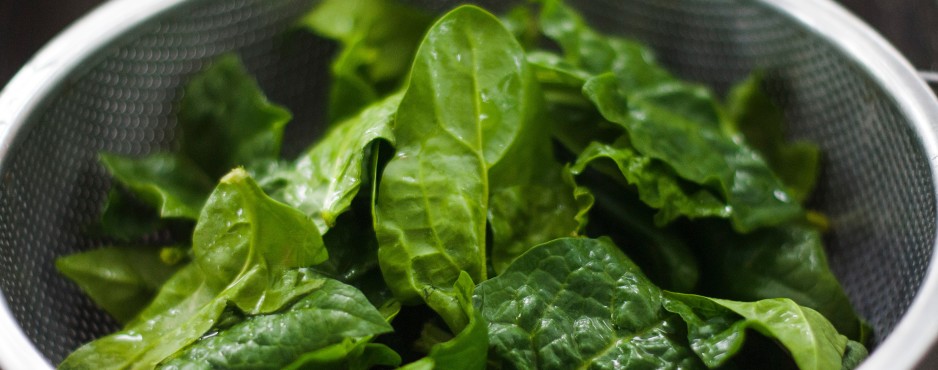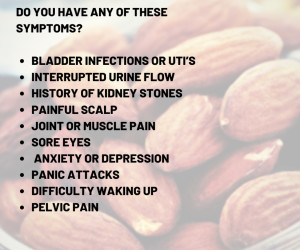Do you eat a lot of spinach or nuts? Then stop and read this! You may have an oxalate problem!
Do you have any of these symptoms?
- Bladder infections or UTI’s
- Interrupted urine flow
- History of kidney stones
- Painful scalp
- Joint or muscle pain
- Sore eyes
- Fibromyalgic type pain
- Brain fog
- Anxiety or depression
- Panic attacks
- Difficulty waking up
- Pelvic pain
- Disturbed sleep
- Histamine issues
- Carpal tunnel syndrome
- Vulva pain
- Osteoporosis
You may have a build-up of oxalates. What is an oxalate? Oxalates are found in many foods and are there to help the plant bind calcium so that it can grow. In our bodies it does the same thing (binds minerals-for us this is not good!). If you have the appropriate environment and functioning enzymes then the oxalates are broken down and eliminated.
We have a few enzymes (genes) in our body that work to breakdown the oxalates found in many of the foods we consume on a regular basis. The top culprits being spinach, nuts (especially almonds) soy, wheat, potatoes, brown rice flour, chocolate, buckwheat, berries, celery and carrots (there are more). Oxalates can also be a byproduct of metabolism. Excess vitamin C gets converted to oxalates! Sometimes we use mega doses when sick, some people take it to bowel tolerance to help with constipation. We’ve always been told we will just pee out what we don’t use, but for some people this is not true! You must avoid high doses of C if you have these genes (or symptoms)
Beware! If there are variations in these genes or you overload the system, the enzymes may not work as well and the oxalates will bind with calcium and other minerals in the body and turn into sharp crystals that can accumulate in the urinary tract (kidney stones) or deposit in joints, muscles, eyes and GI tract causing an overwhelming amount of symptoms.
Symptoms can present when eating high oxalate foods. I’ve had clients who have immediate shoulder pain after eating. Sometimes you will have flares, this is when you have a release of stored oxalates for one reason or another. Some people do not have actual symptoms until they stop eating high oxalate foods, but they may have low minerals, be at risk for osteoporosis, have IBS type symptoms or be on their way to kidney failure etc. this is a storm brewing. If you have variations in your oxalate genes it is important to take this seriously.
Never remove all these foods at once. Oxalate dumping is a real thing and can be very painful. If you have any of these symptoms and have variations in your oxalate degrading genes, you may benefit from removing some of these foods (slowly) with the help of a nutritionist. Taking specific supplements and probiotics that help bind and break down the oxalates can also be helpful.
Oxalate dumping symptoms:
- At first none! This is the honeymoon phase, this may be the first time in years that your aches and pains disappear, your GI system feels like its working, your brain may not feel foggy. In some studies austistic children show immediate gains in symptoms. But beware if you did this abruptly this does not last….
- Oxalates bind to minerals so some of the symptoms of dumping will be similar to low magnesium: muscle aches, twitching, cramps.
- Since B-vitamins are readily being used up, symptoms of low B’s can abound: migraines, skin issues
- Histamine flares
- Constant sinus drainage
- Cloudy urine
- Sandy looking stools
- Black specks in your urine or stool
- GI distress like diarrhea or constipation
- Yeast overgrowth
Currently a high oxalate intake is defined as eating more than 250mg of oxalate per day. One cup of spinach contains 656mg of oxalates! Eating spinach requires the body to work hard to process those oxalates and uses up a lot of B6 to do this.
Hyperoxaluria Type 1 is coded by the AGXT gene. When this enzyme is not working properly glyoxylate is converted to oxalate which forms insoluble calcium salts that can accumulate in the kidneys or other organs. If you have these variations, you are more prone to kidney stones. Hyperoxaluria Type 2 is coded by the GRHPR gene and Hyperoxaluria type 3 is coded by the HOGA1 gene. These are usually more related to joint pain versus kidney stones.
Biggest culprits:
| Almonds | 122mg | 22 kernels |
| Avocado | 19mg | 1 fruit |
| Baked potato | 97mg | 1 medium |
| Beans | 15-75mg | 1/2 cup |
| Beets | 76mg | 1/2 cup |
| Brewed tea | 14mg | 1 cup |
| Brown rice flour | 24mg | 1 cup |
| Buckwheat | 133mg | 1 cup |
| Bulgur | 86mg | 1 cup |
| Carrot juice | 27mg | 1 cup |
| Cashews | 49mg | 1oz |
| Cocoa Powder | 67mg | 4 tsp |
| Collards | 10mg | 1 cup |
| Dates | 24mg | 1 date |
| Figs dried | 25mg | 5 figs |
| French fries | 51mg | 1/2 cup |
| Millet | 62mg | 1 cup |
| Miso Soup | 111mg | 1 cup |
| Orange | 29mg | 1 orange |
| Potato chips | 21mg | 1 ounce |
| Raspberries | 48mg | 1 cup |
| Rhubarb | 541mg | 1/2 cup |
| Rice bran | 281mg | 1 cup |
| Soy milk | 336mg | 1 cup |
| Soy nuts | 392mg | 1 ounce |
| Soy protein | 496mg | 3 ounces |
| Spinach raw | 656mg | 1 cup |
| Sweet potato | 28mg | 1 cup |
| Tofu | 235mg | 3 ounces |
| Walnuts | 31mg | 7 nuts |
| Wheat flour | 29mg | 1 cup |
| Yam | 40mg | 1/2 cup |
Source: St Joseph’s Healthcare Hamilton
Harvard T.H. Chan School of Public Health
Here is a searchable data base with 750 foods and their oxalate content
There is some discrepancy in the amount in broccoli, to be safe boiling your broccoli before you eat it and discarding the water removes a large portion of the oxalate content, you can also do this with nuts.
I especially see this as a major problem for people that are juicing regularly, on a paleo diet that includes a lot of almond flour and/or milk, people eating a lot of gluten free products or bars (almost all bars contain nuts!) and vegetarians/vegans that are eating a lot of soy products.
Remember you can still have oxalate build-up with out the genes and trialing a low-oxalate diet may be helpful, but for people that will have a life-long problem knowing your genetic predispostion is important. Magnesium and calcium citrate can be included as a supplement to help bind the oxalates as well as certain strains of probitiocs to help degrade them (calcium should not be daily if CVD risk). Our gut bacteria can also make oxalates!
Think you may have an oxalate issues? Visit omicsdna.com to run either a mini diet panel that will tell you if you have variations in these genes or a full diet panel with testing.

